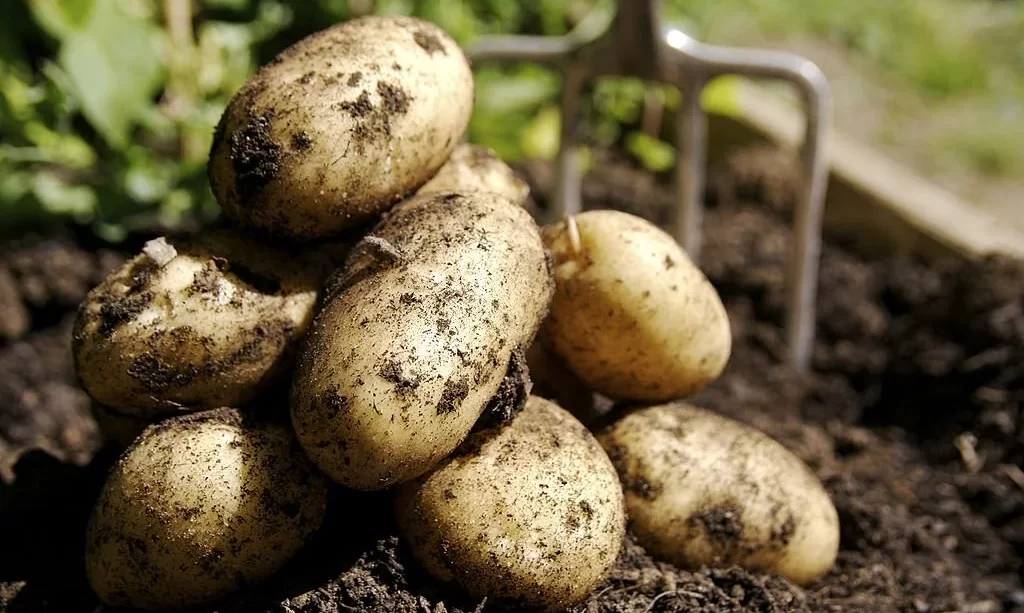Potatoes, with their versatility and culinary appeal, have long been a staple in gardens and kitchens worldwide. While many gardeners traditionally plant potatoes in the spring for a summer harvest, there’s a lesser-known but equally rewarding practice: planting potatoes in the fall. Fall potato planting opens up a world of possibilities for late-season harvests and extended enjoyment of homegrown spuds. In this article, we’ll delve into the art of growing potatoes in the fall, exploring the advantages, techniques, and considerations that make it a valuable addition to your gardening repertoire. If you’ve ever wondered whether it’s possible to cultivate these beloved tubers as the weather cools down, read on to discover the benefits and secrets of planting potatoes in the fall.
- Simply Seed – Fresh 2024 Seed for Fall Planting –
- Non GMO And Packed In Organtic Peat Moss
- Top quality Tubers Are Hand Selected And Packaged Once Order Is Placed
- Receive 5 Full Pounds Of Beautiful Russet Burbank Potatoes.
- Order Now So You Can Have Fresh Potatoes From Your Garden For Your Family
The Advantages of Fall Potato Planting
Planting potatoes in the fall offers a host of advantages that make it an enticing option for gardeners seeking extended harvests and reduced pest pressures. One of the primary benefits is the diminished competition from pests. As the growing season progresses into the fall, many of the insect pests that plague potatoes earlier in the year decline in numbers, reducing the risk of infestations. Additionally, fall-planted potatoes often yield higher quantities with fewer pest issues, allowing for bountiful harvests. Some potato varieties are particularly well-suited for fall planting, capitalizing on cooler temperatures to develop excellent flavor and texture. These advantages, combined with the joy of digging up fresh potatoes as the autumn leaves turn, make fall potato planting a rewarding venture for gardeners looking to savor the flavors of the season and beyond.
Preparing for Fall Potato Planting
Preparing for fall potato planting involves several essential steps to ensure a successful late-season harvest. It begins with selecting the right potato varieties, as some are better suited for fall planting. Varieties that mature relatively quickly are ideal for fall cultivation since they can make the most of the remaining growing season. Timing is crucial, and fall potato planting typically occurs several weeks before the first expected frost. This ensures that the tubers have enough time to develop before cold temperatures set in. When preparing the soil, focus on well-draining soil with good aeration, as potatoes despise waterlogged conditions. Proper soil preparation, including amending with organic matter and ensuring a pH level between 5.0 and 6.0, is vital for the health and productivity of fall-planted potatoes.
- 🌳 PROFESSIONALLY MIXED IN THE USA – Each bag is hand blended on our small family farm with premium horticultural grade ingredients: Coco Coir, Canadian Peat Moss, Perlite, Worm Castings- 2 QUART BAG
- ✅ PROMOTES RAPID ROOT DEVELOPMENT: With extra perlite and low-salt coconut coir, GARDENERA soil promotes rapid root development .
- 💧 SUPER MOISTURE DRAINAGE- Protects roots by quickly draining away excess water but keeping dirt moist for nutrient retention, best mimics their natural outdoor environment.
- ✅ APPROVED FOR ORGANIC GROWING: All Gardenera Organics premium potting soils are made in the USA 🇺🇸 and contain no additives, proving them great for use in organic growing.
- 🌱 DEVELOPED BY PLANT PARENTS FOR PLANT PARENTS – Crafted specifically to support the growth of Potatoes. This high quality hand crafted mix is great for Potatoes. It will allow your plant to grow and become large and healthy.
Planting Fall Potatoes
Planting fall potatoes follows similar principles to spring planting but with a few adjustments. Start by acquiring certified disease-free seed potatoes to ensure a healthy start. The planting process involves digging trenches or individual holes, with spacing between plants of about 12 inches. Place the seed potatoes in the soil with the eyes facing upward, typically at a depth of 3 to 4 inches. The space between rows should be approximately 2 to 3 feet to allow for proper growth and air circulation. After planting, consider mulching around the potato plants to help regulate soil temperature and moisture. Mulching can prevent rapid soil temperature fluctuations and reduce the need for frequent watering, especially as the weather cools.
Caring for Fall-Planted Potatoes
Caring for fall-planted potatoes is essential to ensure a successful late-season harvest. Watering is a crucial aspect of care, with potatoes typically needing about 1 to 2 inches of water per week. It’s essential to maintain consistent moisture levels, especially during dry spells. Fertilization is also important, and applying a balanced fertilizer at planting and again when the plants emerge can provide the necessary nutrients for robust growth. Be vigilant for late-season pests and diseases, as some may become more active as temperatures cool. Regular inspections and prompt action are key to addressing any issues that may arise. Additionally, consider providing frost protection when needed. Covering the potato plants with row covers or blankets can help shield them from early frost, extending the growing season and allowing the tubers to reach maturity. Proper care throughout the fall ensures that your late-season potato harvest is a success, yielding delicious and nutritious spuds for your table.
- NPK Composition: 6-3-9
- Great for sweet potatoes, bakers, boilers and reds
- Encourages all-around growth
- Includes spoon
- 3 Lbs. package
Harvesting Fall Potatoes
Harvesting fall potatoes is a moment of anticipation and reward. Typically, the late-season harvest occurs just before the ground freezes. Determining the right time to dig up your potatoes involves looking for signs of maturity. Mature potato plants will have lush foliage that starts to yellow and die back. When you notice this happening, it’s a good indicator that the tubers are ready for harvesting. To harvest, use a garden fork or spade to gently loosen the soil around the plants. Take care not to damage the potatoes during this process. Once the potatoes are unearthed, allow them to air-dry on the soil surface for a few hours. This helps toughen their skin for storage and reduces the risk of disease. Afterward, store the harvested potatoes in a cool, dark, and well-ventilated space to keep them fresh for an extended period.
Storing Fall-Harvested Potatoes
Properly storing fall-harvested potatoes is crucial to enjoying their quality and flavor over an extended period. Curing the potatoes is the first step. Place them in a well-ventilated area with temperatures between 45°F and 60°F (7°C to 15°C). This curing process takes about two weeks and allows the skin to thicken and any minor wounds to heal, increasing their shelf life. Once cured, store the potatoes in a cool, dark location, ideally around 40°F (4°C). Basements, root cellars, or cool garages are suitable choices. Keep them away from direct sunlight, which can cause the potatoes to turn green and develop a bitter taste. Properly stored, fall-harvested potatoes can last for several months, providing a fresh and homegrown source of this versatile vegetable well into the winter.
Conclusion
In conclusion, planting potatoes in the fall offers gardeners a delightful opportunity to extend their growing season and enjoy fresh, homegrown spuds when the weather cools down. The advantages of fall potato planting, such as reduced pest pressures and potentially higher yields, make it a compelling choice for those willing to explore late-season cultivation. Preparing for fall planting involves careful selection of potato varieties and soil preparation, while planting and caring for fall potatoes follows familiar principles with some seasonal adjustments. Harvesting the tubers at the right moment, curing them, and then storing them properly ensures a steady supply of delicious, homegrown potatoes well into the winter months. So, for those who relish the idea of savoring the flavors of fall and beyond, planting potatoes in the autumn is a rewarding and satisfying endeavor that reaps delicious dividends at the dinner table.






